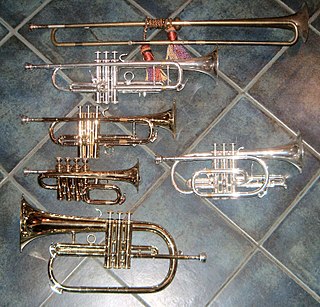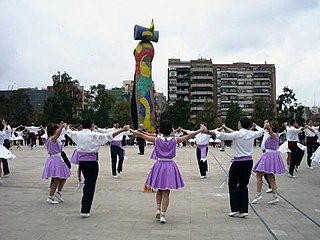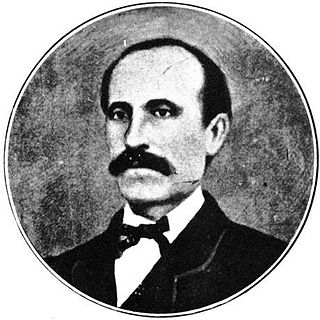
The cobla (Catalan pronunciation: [ˈkobːlə] , plural cobles) is a traditional music ensemble of Catalonia, and in Northern Catalonia in France. It is generally used to accompany the sardana, a traditional Catalan folk dance, danced in a circle.

The cobla (Catalan pronunciation: [ˈkobːlə] , plural cobles) is a traditional music ensemble of Catalonia, and in Northern Catalonia in France. It is generally used to accompany the sardana, a traditional Catalan folk dance, danced in a circle.
The modern Cobla normally consists of 11 players with the following instruments:
There are small variations to this instrumentation in contemporary coblas: for example there is sometimes a third trumpet player.
The playing formation has two rows. The front row has (as seen by the audience from left to right) the flabiolist (with pipe and drum), the second and first tibles, and the first and second tenores. The back row, often raised, has the second and first trumpets, the trombone, and the first and second fiscorns. The double bass player, often standing, is on the right of the band.

Originally, the cobla was a 3-piece band:
The main instrument in the cobla, the tenora, was developed around 1850 by French-Catalan luthier Andreu Toron, in Perpignan/Perpinyà.
The modern 11-piece cobla was developed by the Catalan musician Josep Maria "Pep" Ventura. He wrote over 200 Sardana compositions.

A brass instrument is a musical instrument that produces sound by sympathetic vibration of air in a tubular resonator in sympathy with the vibration of the player's lips. Brass instruments are also called labrosones or labrophones, from Latin and Greek elements meaning 'lip' and 'sound'.

The euphonium is a medium-sized, 3 or 4-valve, often compensating, conical-bore, tenor-voiced brass instrument that derives its name from the Ancient Greek word εὔφωνος euphōnos, meaning "well-sounding" or "sweet-voiced". The euphonium is a valved instrument. Nearly all current models have piston valves, though some models with rotary valves do exist.

The flugelhorn, also spelled fluegelhorn, flugel horn, or flügelhorn, is a brass instrument that resembles the trumpet and cornet but has a wider, more conical bore. Like trumpets and cornets, most flugelhorns are pitched in B♭, though some are in C. It is a type of valved bugle, developed in Germany in the early 19th century from a traditional English valveless bugle. The first version of a valved bugle was sold by Heinrich Stölzel in Berlin in 1828. The valved bugle provided Adolphe Sax with the inspiration for his B♭ soprano (contralto) saxhorns, on which the modern-day flugelhorn is modelled.

The trombone is a musical instrument in the brass family. As with all brass instruments, sound is produced when the player's vibrating lips cause the air column inside the instrument to vibrate. Nearly all trombones use a telescoping slide mechanism to alter the pitch instead of the valves used by other brass instruments. The valve trombone is an exception, using three valves similar to those on a trumpet, and the superbone has valves and a slide.

A transposing instrument is a musical instrument for which music notation is not written at concert pitch. For example, playing a written middle C on a transposing instrument produces a pitch other than middle C; that sounding pitch identifies the interval of transposition when describing the instrument. Playing a written C on clarinet or soprano saxophone produces a concert B♭, so these are referred to as B♭ instruments. Providing transposed music for these instruments is a convention of musical notation. The instruments do not transpose the music; rather, their music is written at a transposed pitch. Where chords are indicated for improvisation they are also written in the appropriate transposed form.

The baritone horn, sometimes called baritone, is a low-pitched brass instrument in the saxhorn family. It is a piston-valve brass instrument with a bore that is mostly conical, like the higher pitched flugelhorn and alto (tenor) horn, but it has a narrower bore compared to the similarly pitched euphonium. It uses a wide-rimmed cup mouthpiece like that of its peers, the trombone and euphonium. Like the trombone and the euphonium, the baritone horn can be considered either a transposing or non-transposing instrument.

The music of Catalonia comprises one of the oldest documented musical traditions in Europe. In tandem with the rest of Western Europe, it has a long musical tradition, incorporating a number of different styles and genres over the past two thousand years.

The sardana is a Catalan musical genre typical of Catalan culture and danced in circle following a set of steps. The dance was originally from the Empordà region, but started gaining popularity throughout Catalonia from the late 19th century to beginning of the 20th century after the modernisation done by Josep Maria Ventura i Casas.

An alta cappella or alta musica (Italian), haute musique (French) or just alta was a kind of town wind band found throughout continental Europe from the thirteenth to the eighteenth centuries, which typically consisted of shawms and slide trumpets or sackbuts. Waits is the British equivalent. These were not found anywhere outside of Europe.

As Europe experienced a wave of roots revivals in the 1950s and 1960s, France found its regional culture reviving traditional music. Brittany, Limousin, Gascony, Corsica and Auvergne were among the regions that experienced a notable resurgence in the popularity of folk music. Traditional styles of music had survived most in remote areas, such as the island of Corsica and mountainous Auvergne, as well as the more nationalist lands of the Basques and Bretons.

The flabiol is a Catalan woodwind musical instrument of the family known as fipple flutes. It is one of the 12 instruments of the cobla. The flabiol measures about 25 centimeters in length and has five or six holes on its front face and three underneath.
Banda is a subgenre of regional Mexican music and type of ensemble in which wind and percussion instruments are performed.

Marching brass instruments are brass instruments specially designed to be played while moving. Most instruments do not have a marching version - only the following have marching versions:

A brass band is a musical ensemble generally consisting primarily of brass instruments, most often with a percussion section. Ensembles that include brass and woodwind instruments can in certain traditions also be termed brass bands, but may be more correctly termed military bands, concert bands, or "brass and reed" bands.

In music, a Catalan shawm is one of two varieties of shawm, an oboe-like woodwind musical instrument played in Catalonia in northeastern Spain.

The tambori is a percussion instrument of about 10 centimetres diameter, a small shallow cylinder formed of metal or wood with a drumhead of skin. Its usual function is to accompany the playing of the flabiol in a cobla band, beating the rhythm of the sardana, the traditional dance of Catalonia.

The xeremia is a type of bagpipe native to the island of Majorca (Mallorca). It consists of a bag made of skin, known as a sac or sarró which retains the air, a blowpipe (bufador), a melody pipe or chanter (grall), and several, generally three, drones (bordons). The primary drone (roncó) sounds a tonic note, but the other drones are sometimes simply false drones for ornamentation.

A fiscorn is a brass instrument. It is a bass flugelhorn in the key of C. In the cobla, it has the deepest sound among the brass instruments.

Josep Maria Ventura i Casas, popularly known as Pep Ventura, was a Spanish musician and composer from Catalonia who consolidated the long sardana and reformed the cobla, adding instruments to give it its current formation.
Vicenç Bou i Geli was a Catalan Spanish composer. He was most well known for his compositions of the traditional sardanes, which he wrote with great fluency and little sophistication, but with a gift for charming and ingenious melody.